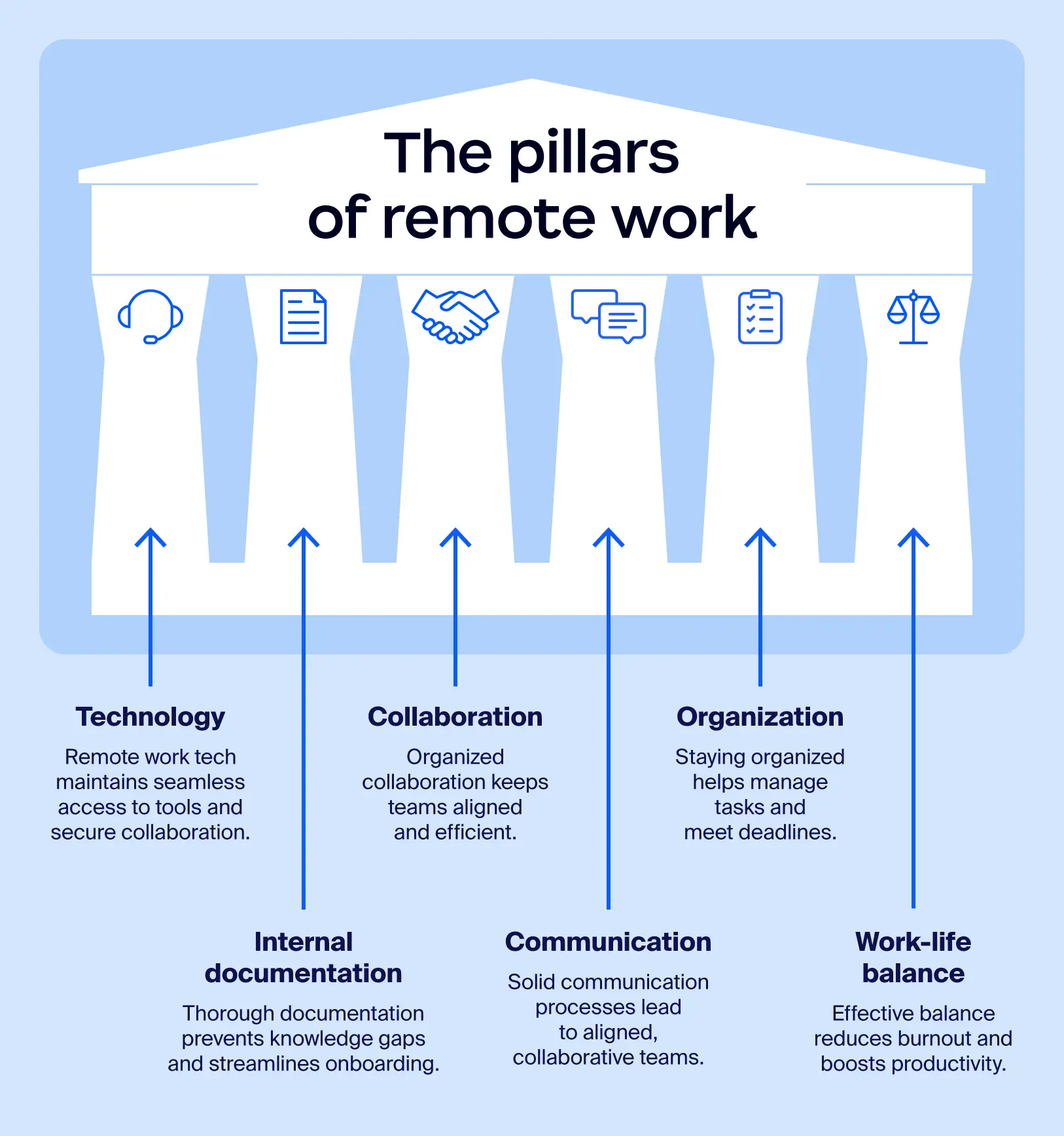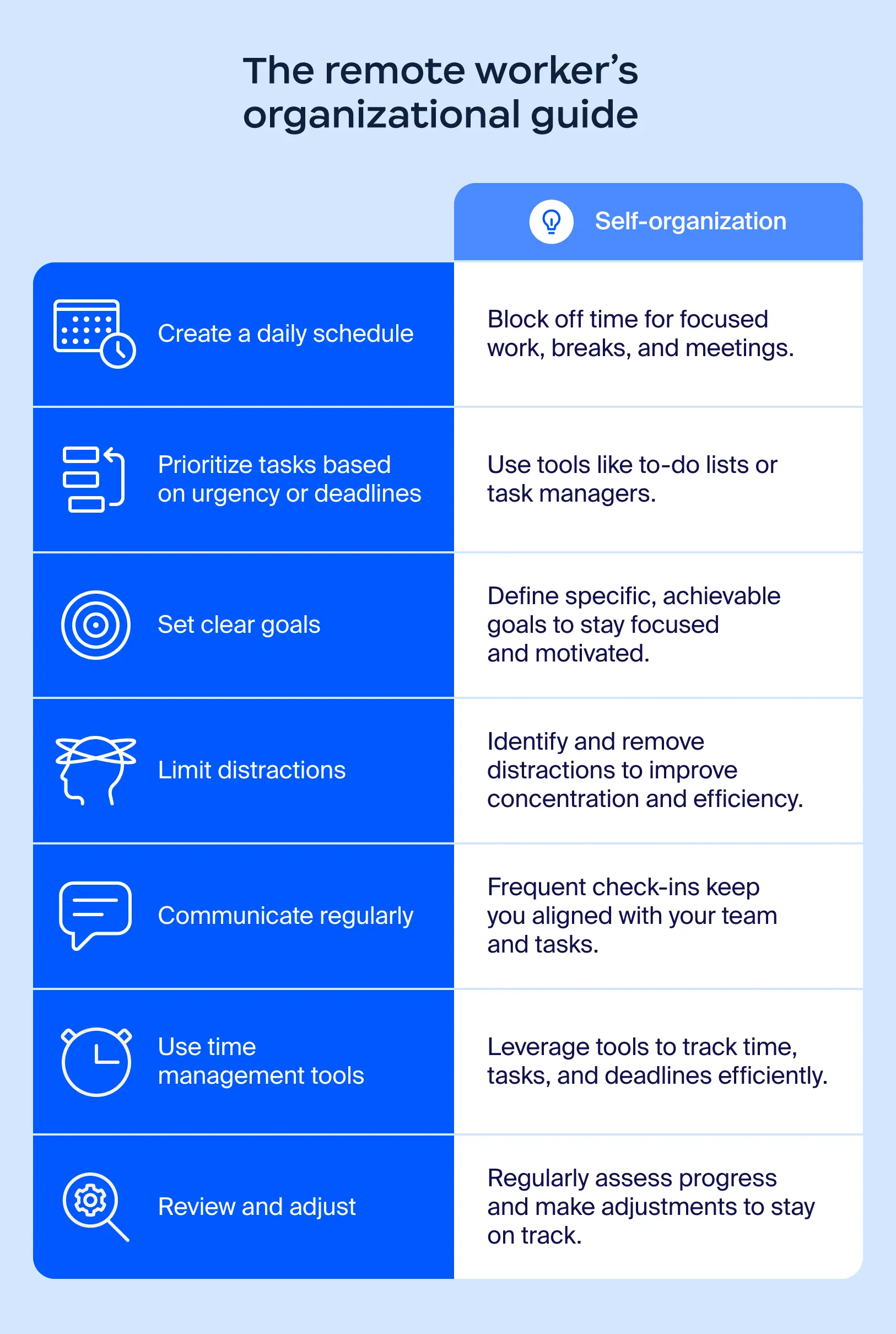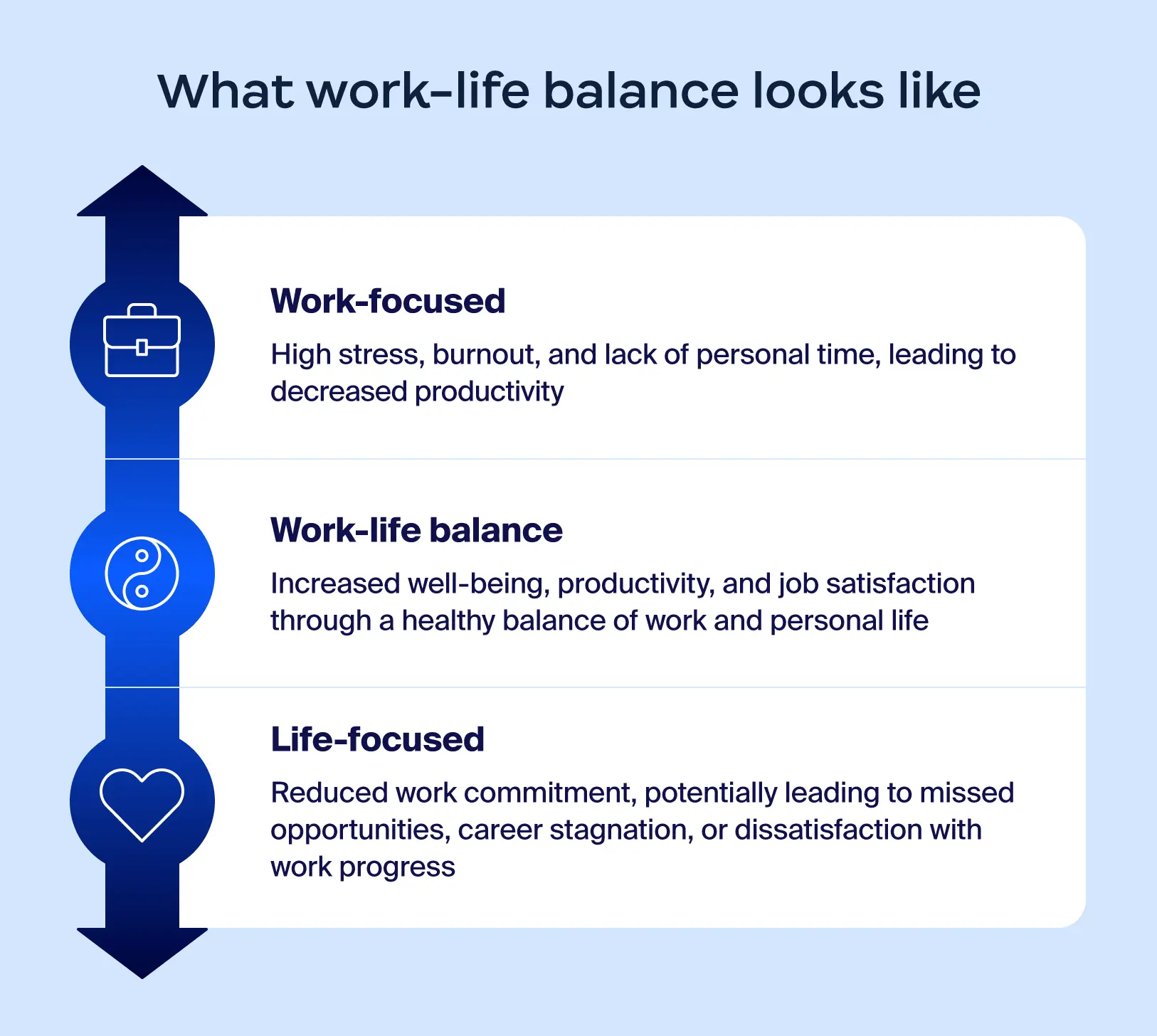
Meet Zoom AI Companion, your new AI assistant!
Boost productivity and team collaboration with Zoom AI Companion, available at no additional cost with eligible paid Zoom plans.
Updated on April 18, 2025
Published on April 18, 2025


Remote work has evolved the way we do business and how we tackle our to-do lists — so much so that 75% of employees believe their organization’s current remote work tools and technology need upgrades.
Adjusting to a remote work model requires changes, and we’re here to help you adapt.
In this guide, we’ll share remote work tips for both leaders and individuals, exploring how the right tools can boost productivity while fostering a stronger, more connected team.
Remote and hybrid work models offer flexibility, but they can also pose unique challenges, including:

As a leader managing remote or hybrid teams, setting your team up for success is more than just assigning tasks. From streamlining communication processes to fostering team dynamics, here are some remote work tips to help you lead confidently and set your team up for success.
Collaboration is the backbone of an efficient team. It bridges gaps, fosters creativity, and strengthens cohesion — all of which are critical for thriving in a remote or flexible setup.
To empower your remote team, try these strategies:
Finding a communication rhythm for remote teams can feel like a juggling act, especially if your team members are located in different time zones. Set clear expectations on how and when to communicate to keep things flowing smoothly, no matter where your team is dialing in from.
To establish communication processes, start with these remote work tips:
For remote teams, the right tech stack can drive productivity. Here’s how to set your team up for success:
In a remote setup, it’s easier for things to slip through the cracks, especially if team members are working independently or across different time zones. Regular check-ins help you stay connected with progress and align on goals.
One-on-one sessions allow team members to voice concerns or ask for help — things that may not surface in busy chat threads.
Tip: Weekly or biweekly check-ins are ideal for most teams to maintain momentum.
It’s important to balance flexibility with a clear framework for accountability. A well-balanced approach keeps everyone aligned and driven toward shared goals. Here’s how to strike that balance effectively:
As a leader, prioritizing your own well-being sets the tone for your team. By modeling healthy work habits, you can motivate your team to adopt similar practices.
Lead by example: Log off at a reasonable hour and take regular breaks to recharge and prioritize self-care. These habits lend themselves to better work-life balance and long-term productivity.
Hybrid work trends show that 67% of businesses retain employees best when they offer flexible hours.
Rather than micromanaging the clock, focus on your team's results. This means evaluating employees based on the quality of their work and the impact of their contributions rather than the number of hours they spend online.
This results-based approach allows employees to work during their most productive hours. Giving your team the opportunity to own their work lets them focus on what really matters: outcomes that move the business forward.
Feedback should feel as natural as a coffee break. When employees trust that their input is respected, it fosters creativity and better team dynamics, which then impacts success.
Here are some effective ways to encourage open feedback:
Investing in upskilling remote teams isn’t just improving current skills; it’s showing that you’re committed to your team’s future success. Below are a few ways you can invest in employee development.
These initiatives can enhance employee satisfaction and help build a team that’s motivated and equipped to handle new challenges.
The flexibility of remote work allows you to tailor your work hours to your natural rhythms. Here are some tips for working remotely to help you stay on track.
To maximize productivity, determine when you’re most focused and energized. Establish these work-from-home tips as daily habits to support long-term success:

Stepping away from your desk, even for just a few minutes, helps refresh your mind. To boost energy levels and improve focus throughout the day, consider these tips:

Maintaining focus in a remote setting starts with thoughtful planning. These actionable tips for working from home can structure your workday to track progress effectively.
By combining these strategies, you can be better organized and accountable for any remote or hybrid setup.
To adapt to flexible work, continuously experiment with tools to find what fits your work style. Here’s how to fine-tune your workflow effectively:
A dedicated workspace signals to your brain that it’s time to work, helping you stay in the zone and improve productivity. Ideally, this space should be separate from personal or relaxation areas to create a clear boundary between work and downtime.
Tip: An ergonomic chair, functional desk, and quality lighting create a comfortable work setup.
Deep work, or focused time for high-priority tasks, is essential for meaningful results. To improve the quality of your output, schedule dedicated blocks of time to minimize distractions and tackle tasks that require critical thinking.
Optimize deep work blocks by snoozing notifications or using apps to hide your inbox, and schedule these sessions during your peak productivity hours.
Tip: Inform your team of your availability to avoid interruptions.
Clear and frequent business communication is the glue that keeps remote teams connected and productive. Regular video calls, team chats, and weekly updates keep everyone on the same page and build a sense of camaraderie.
Remember, fostering personal connections with the team matters, too. Share wins, celebrate milestones, or even throw in a fun meme now and then. Open and transparent communication strengthens relationships and makes remote work feel a little less remote.
The right systems and productivity tools are key to staying organized and on top of your tasks.
Experiment with different tools to find the ones that work best for your workflow, and use them consistently to power through your to-do lists.
Feedback is a powerful tool for personal and professional growth, especially in a remote work environment. Proactively seek input from managers and peers to see if you’re aligned with expectations rather than waiting for formal reviews.
Whether it’s a quick check-in after a project or a casual chat during a one-on-one meeting, feedback fosters a stronger connection with your team and shows a commitment to continuous improvement.
Successful remote work is all about balance. By adopting smart remote working tips, teams can stay productive and achieve their goals, no matter the distance.
Zoom Workplace simplifies remote work with AI-powered tools like video conferencing, integrated chat, and file-sharing. Whether you’re hosting brainstorming sessions or collaborating in real time, Zoom equips you with the tools you need to do more with less.